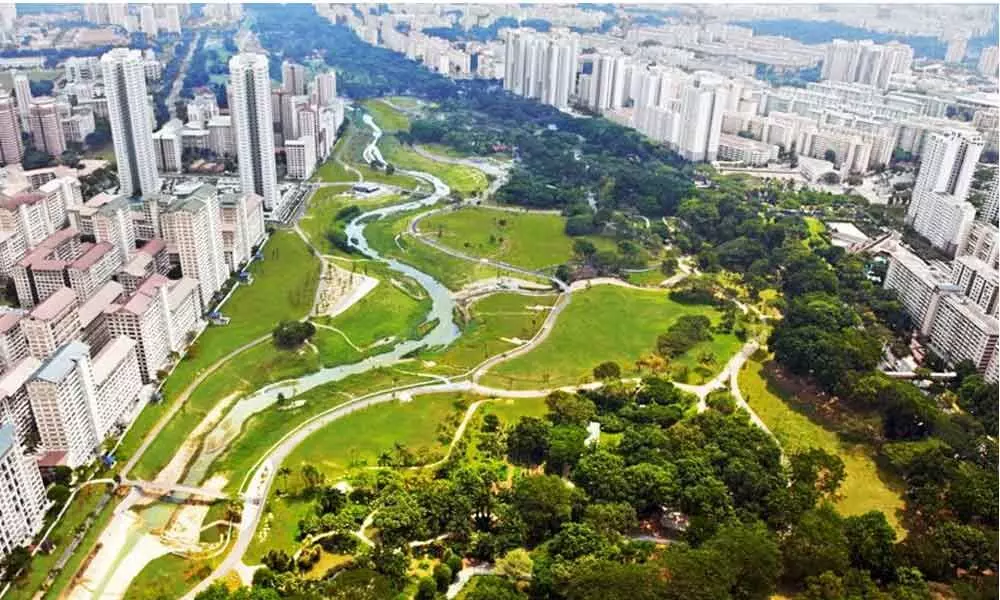Live
- Study explains mechanisms behind food poisoning, gut infections
- UN warns armed violence deepens humanitarian crisis in Sudan
- Maha Vikas Aghadi will win over 160 seats, form government in Maharashtra, says Shivakumar
- 6 Factors to Consider While Choosing the Right IVF Clinic in Hyderabad
- PM Modi emplanes for three-nation visit to Nigeria, Brazil, Guyana
- Chandrababu stresses on deregulation in telecom sector at Hindustan Times conference
- MP govt to promote 'Gita Jayanti' like other festivals
- Sidhant Gupta Revolutionises India’s Dairy Sector with Cutting-Edge Technology
- National Press Day 2024: Honouring Journalism in the Digital Era
- Margashirsha 2024: Dates, Rituals, and Spiritual Significance
Just In
Crumbling urban infrastructure: Need for greenfield urban centres


Crumbling urban infrastructure: Need for greenfield urban centres
More than anything else monsoon exposes the shortcomings and gaps in the urban infrastructure in India. It has now become normal for Mumbai to come to a grinding halt for a few days on heavy rainy days in the monsoon
More than anything else monsoon exposes the shortcomings and gaps in the urban infrastructure in India. It has now become normal for Mumbai to come to a grinding halt for a few days on heavy rainy days in the monsoon . Normally cities located away from the coast escape this type of a deluge though traffic snarls and inundated roads are common in all these cities on any rainy day.
But this year it was unusual in Hyderabad when the city received one fourth of its annual rainfall in one day resulting in large-scale inundation and rain water entering houses and office complexes. Information technology offices of companies like Infosys and others are also not spared.
At the root of the problem is the reluctance of the State government to invest adequately in urban infrastructure. All State governments look at urban centres as milch cows generating surpluses for distribution to their electoral lobbies not necessarily the most deserving, and for taking up projects which can generate kickbacks for their electoral funds. But this neglect of urban infrastructure can end up as killing the goose that lays the golden eggs.
With competition from across the globe to attract investments the urban centres in India will have to compete globally to attract investments. Given creaking urban infrastructure it's only a matter of time before investment starts looking for alternative urban centres in other countries.
Government of India is trying to improve the urban infrastructure in terms of certain specific programs like smart cities, Amrut etc but unless the State governments own up the urban centres start investing substantially on infrastructure facilities in these cities they may not improve to a level where they can internationally compete to attract investments .
Cities like Hyderabad and Bangalore attract substantial investments in spite of the poor urban infrastructure because of huge talent pool that exist in these big cities. That is one reason why mostly back offices get located in these cities while the headquarters and regional offices always get located in places like Singapore and Hong Kong .
Calcutta ,Chennai ,Mumbai which were the capitals of the British presidencies had a unique multilingual cosmopolitan culture under the British. India had an opportunity of declaring them as union territories at the time of independence and invest in them as major growth engines.
The states bifurcated on linguistic basis could have been advised to set up their own capitals as per their choice. But that opportunity is lost and today all these presidency capitals are under the control of respective states organised on linguistic lines.
It would be worthwhile for Government of India to explore the possibilities of setting up greenfield urban centres initially one on the East coast and the other on the West coast. They should develop as union territories with a dedicated port and defined hinterland which can be an industrial area. Necessary arrangement can be worked out with State governments for procurement of land by getting into an agreement to share the revenues generated by these urban centres with those States .
Other than sharing of revenue state should not have any say in running these union territories. Since the urban centres are going to be green field the development will not be constrained by the existing urban agglomerations hence they can be built to compete with any of the best urban agglomerations in the world. That is the only way India can remain competitive in providing the necessary quality urban infrastructure to attract investments.
Let us not forget when Mumbai was a thriving port city and was a major hub in the East Singapore and Hong Kong, Dubai were nowhere in the picture. It just took few decades of good leadership and adequate investment in urban infrastructure to make these cities major commercial hubs in the East while cities like Mumbai, Kolkata went from bad to worse.

© 2024 Hyderabad Media House Limited/The Hans India. All rights reserved. Powered by hocalwire.com






